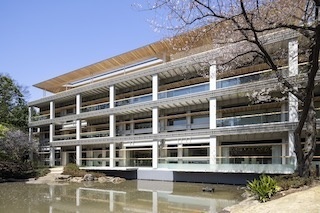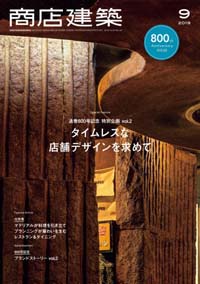SHOTENKENCHIKU /April
2023/03/28 2023

April 2023, SUMMARY
SHOTENKENCHIKU is monthly magazine of Japanese interior design / store design / commercial architecture
SPECIAL FEATURE1
ACCOMMODATION
SHIJO KAWARAMACHI ONSEN SORA NIWA
TERRACE KYOTO / BETTEI KAMOGAWA
(Page 46)

The hotel is located in the Shijo Kawaramachi area, Kyoto's
largest downtown area, making it easy to access famous
sightseeing spots. It was planned as a new Japanese inn that
combines the efficiency of an urban hotel with the openness of a
resort hotel. It consists of "Solaniwa Terrace Kyoto" with compact
guest rooms and luxurious "Bettei Kamogawa" where you can feel
the charm of locality. The hotel pumps up natural hot spring water
and supplies it to the large public bath, rooftop bath, and guest
room of Bettei Kamogawa. Te interior is modern and warm, with
carefully selected materials that create Japanese atmosphere.
Textiles, carpets, signages, and lighting fixture traditional
Japanese motifs, harmonizing with the modernism and Japanese
tastes of entire hotel.
Designer : ISHII ARCHITECT OFFICE
SPECIAL FEATURE1
ACCOMMODATION
TSURUGA HIGASHIYAMASOUHONZAN
(Page 82)

Located in Higashiyama Onsen, an annex, as it were, to Aizu,
Fukushima prefecture, this project is a remodeling of traditional
Shouwa era wooden ryotei originally built by shrine carpenters
over the course of eight years. It has been reborn as an auberge
style kaiseki ryokan, limited to one group per day. A cypress
bathtub is installed in the bathroom. When you open the large
glass door of the bathroom, it becomes an open-air bath
overlooking the bamboo grove and the river. The floor of the openair
bath is covered with waterproof tatami, and you can feel a
sense of unity with the guest room. Sauna is available and guests
can soothe their bodies and minds while listening to the
murmuring of the river. The dining room has a table from a single
solid piece of local Aizu zelkova. At the counter seats in the back,
you can freely enjoy seasonal local sake directly from dispensers.
Designer : INVI
SPECIAL FEATURE1
ACCOMMODATION
〈Report / Before and After of Two Old Ryokan〉
Japanese Inn MIKIYA / HONKAN KOSEKIYA
(Page 90)

Long-established ryokan have a proud history and have been
loved by generations. Here we have two projects that explored
interiors that connect to the future while making the most of
existing traditional facilities and atmosphere. Mikiya is located in
Kinosaki, Hyogo, and is an inn with a long history where famous
novelist Naoya Shiga wrote "At Kinosaki." The interior inherits the
heritage design of yesteryear, reinterpreting it in a modern way,
and is a design that fuses newness and oldness over time.
Honkan Koseiya is a log-established ryokan nestled in nostalgic
townscape of Ginzan onsen. While retaining the pillars and beams
of old structure, it merges natural-dried timber and the
authentic feeling of the building.
Designer : CASE-REAL kazuhiro seno + atelier Art
SPECIAL FEATURE1
ACCOMMODATION
AUBERGE TEBIRO 1732
(Page 110)

Auberge on the coast of Amami Oshima island, Kagoshima. The
interior of the restaurant on the 1st floor of the building has
seating around an island table in the center, creating a relaxing
space like a salon. The interior is mostly locally sourced and uses
paints made from ingredients extracted from nature. Plasterers
used banana and sugarcane peels mixed with plastering materials.
There are only four guest rooms on the ground floor of the building
where you keep privacy easily. There is only one ocean view guest
room, which is equipped with a desk and chair for workation. This
is an establishment where you can enjoy the charm of Amami
Oshima through the food and atmosphere.
Designer : Ryo Matsui Architects
FEATURE ARTICLE
WEDDING CHAPEL,BANQUET & Shops
TOGO-NO-MORI TOGO-KINENKAN
(Page 130)

The aim of this project was to create new value for Togo Kikenkan
while respecting the location of the existing heritage buildings on
the site, which was built more than 50 years ago.
In order to reduce the weight of the building and strengthen its
seismic reinforcement, the roof slab was dismantled and replaced
with a steel roof, and a new steel balcony was installed as
structural reinforcement by the put-frame method. In addition to
improving functionality such as earthquake resistance and
longevity, the designer also worked on creating value to improve
the attractiveness of the space and they created a new atrium to
revamped flow plan.
By creating a high-quality space where you can feel the
connection with the shrine and the garden, a new identity of the
building as a place of celebration is created.
Designer : FUJIWALAB + SAISEIKENCHIKU LABORATORY
FEATURE ARTICLE
WEDDING CHAPEL,BANQUET & Shops
NOVARESE GINZA
(Page 154)

A dress shop renovation project of about 396㎡ located in Ginza.
This project was started in order to increase the number of fitting
rooms and improve the design, for the number of fitting rooms
was insufficient for that of visiting customers and improvement of
the design was needed. The designer thought that the existing
interior have many white walls and it would give a somewhat lonely
impression, and wanted the space to have a glamorous look as if
it wore a dress. He proposed the concept of "Dress the Space".
He chose a textured fabric for the space, and covered the walls
and structural columns with lace curtains to hide the walls that
were bluntly painted white, and “succeeded in dressing the
space” as intended by the designer.
Designer : Old Kan
SPECIAL FEATURE2
Spatial Design Methods for The Age of Uncertainty
Vol.2 FURNITURE
LYONESSE PICTURES
(Page 182)

Office of video production company LYONESSE PICTURES. This
company mainly produces dramas and movies, and for each
project it creates a work by forming a team with people from
various industries. The office is located on the top floor of a
50-year-old tenant building, and it is a bright place with natural
light pouring through the windows on three sides. The curtains
made of perishable materials fog up when needed, like frosted
glass, so you can't see what's going on inside. Brightly colored
furniture is placed in each corner, creating a gentle border around
the furniture. The designer thought that even if the roles of
workers and spatial functions mixed in the environment, each
space can be divided softly by this method. It is a place where
people can freely gather, communicate, and work comfortably.
Designer : Kii.inc
SPECIAL FEATURE2
Spatial Design Methods for The Age of Uncertainty
Vol.2 FURNITURE
COMMUNITY PARK COCONOVA
(Page 204)

This is a project to renovate the site of a clinic in Nago, Okinawa
Prefecture and open it to the community like a park. It is a plan to
become a new infrastructure for the region and the architect
himself planned and designed it. He kept the interior of the
building in a skeleton to be able to accommodate various activities
such as park, market, school, and work place. Depending on the
purpose of use of the building and the place, various furniture,
shelves, and stalls can be moved or combined to create a multilayered
space for co-creation.
Using materials concrete and perforated concrete blocks unique
to Okinawa, which is commonly seen in Okinawa as well as
versatile materials such as concrete panels and tube pie, they
designed clear details.
Designer : CAT
SUBSCRIBE
Digital Issue : zinio.com
Print Issue : For overseas subscription and order, please contact to the following
BACK NUMBER
このエントリーのURL
URL











